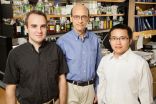(Press-News.org) Certain primordial stars—those 55,000 and 56,000 times the mass of our Sun, or solar masses—may have died unusually. In death, these objects—among the Universe's first-generation of stars—would have exploded as supernovae and burned completely, leaving no remnant black hole behind.
Astrophysicists at the University of California, Santa Cruz (UCSC) and the University of Minnesota came to this conclusion after running a number of supercomputer simulations at the Department of Energy's (DOE's) National Energy Research Scientific Computing Center (NERSC) and Minnesota Supercomputing Institute at the University of Minnesota. They relied extensively on CASTRO, a compressible astrophysics code developed at DOE's Lawrence Berkeley National Laboratory's (Berkeley Lab's) Computational Research Division (CRD). Their findings were recently published in Astrophysical Journal (ApJ).
First-generation stars are especially interesting because they produced the first heavy elements, or chemical elements other than hydrogen and helium. In death, they sent their chemical creations into outer space, paving the way for subsequent generations of stars, solar systems and galaxies. With a greater understanding of how these first stars died, scientists hope to glean some insights about how the Universe, as we know it today, came to be.
"We found that there is a narrow window where supermassive stars could explode completely instead of becoming a supermassive black hole—no one has ever found this mechanism before," says Ke-Jung Chen, a postdoctoral researcher at UCSC and lead author of the ApJ paper. "Without NERSC resources, it would have taken us a lot longer to reach this result. From a user perspective, the facility is run very efficiently and it is an extremely convenient place to do science."
The Simulations: What's Going On?
To model the life of a primordial supermassive star, Chen and his colleagues used a one-dimensional stellar evolution code called KEPLER. This code takes into account key processes like nuclear burning and stellar convection. And relevant for massive stars, photo-disintegration of elements, electron-positron pair production and special relativistic effects. The team also included general relativistic effects, which are important for stars above 1,000 solar masses.
They found that primordial stars between 55,000 to 56,000 solar masses live about 1.69 million years before becoming unstable due to general relativistic effects and then start to collapse. As the star collapses, it begins to rapidly synthesize heavy elements like oxygen, neon, magnesium and silicon starting with helium in its core. This process releases more energy than the binding energy of the star, halting the collapse and causing a massive explosion: a supernova.
To model the death mechanisms of these stars, Chen and his colleagues used CASTRO—a multidimensional compressible astrophysics code developed at Berkeley Lab by scientists Ann Almgren and John Bell. These simulations show that once collapse is reversed, Rayleigh-Taylor instabilities mix heavy elements produced in the star's final moments throughout the star itself. The researchers say that this mixing should create a distinct observational signature that could be detected by upcoming near-infrared experiments such as the European Space Agency's Euclid and NASA's Wide-Field Infrared Survey Telescope.
Depending on the intensity of the supernovae, some supermassive stars could, when they explode, enrich their entire host galaxy and even some nearby galaxies with elements ranging from carbon to silicon. In some cases, supernova may even trigger a burst of star formation in its host galaxy, which would make it visually distinct from other young galaxies.
"My work involves studying the supernovae of very massive stars with new physical processes beyond hydrodynamics, so I've collaborated with Ann Almgren to adapt CASTRO for many different projects over the years," says Chen. "Before I run my simulations, I typically think about the physics I need to solve a particular problem. I then work with Ann to develop some code and incorporate it into CASTRO. It is a very efficient system."
To visualize his data, Chen used an open source tool called VisIt, which was architected by Hank Childs, formerly a staff scientist at Berkeley Lab. "Most of the time I did my own visualizations, but when there were things that I needed to modify or customize I would shoot Hank an email and that was very helpful."
Chen completed much of this work while he was a graduate student at the University of Minnesota. He completed his Ph.D. in physics in 2013.
INFORMATION:
Simulations reveal an unusual death for ancient stars
Findings made possible with NERSC resources and Berkeley Lab Code
2014-09-29
ELSE PRESS RELEASES FROM THIS DATE:
Myriad presents tumor BRACAnalysis CDx study at ESMO
2014-09-29
SALT LAKE CITY, Utah, Sept. 29, 2014 – Myriad Genetics, Inc. (Nasdaq: MYGN) today announced that its Tumor BRACAnalysis CDx™ companion diagnostic test significantly improved the detection of cancer-causing BRCA1/2 mutations by 44 percent in women with ovarian cancer. Data from this new study were presented at the 2014 European Society for Medical Oncology (ESMO) annual meeting in Madrid, Spain.
"Several previous clinical studies have demonstrated that patients with germline or somatic BRCA1/2 mutations respond to certain DNA-damaging medicines such as the platinum ...
Cells from placentas safe for patients with multiple sclerosis
2014-09-29
Patients with Multiple Sclerosis (MS) were able to safely tolerate treatment with cells cultured from human placental tissue, according to a study published today in the journal Multiple Sclerosis and Related Disorders. The study, which is the first of its kind, was conducted by researchers at Mount Sinai, Celgene Cellular Therapeutics subsidiary of Celgene Corporation and collaborators at several other institutions.
While designed to determine safety of the treatment, early signals in the data also suggested that a preparation of cultured cells called PDA-001 may repair ...
Greenland Ice Sheet more vulnerable to climate change than previously thought
2014-09-29
A new model developed by researchers at the University of Cambridge has shown that despite its apparent stability, the massive ice sheet covering most of Greenland is more sensitive to climate change than earlier estimates have suggested, which would accelerate the rising sea levels that threaten coastal communities worldwide.
In addition to assessing the impact of the increasing levels of meltwater created and spilled into the ocean each year as the climate continues to warm, the new model also takes into account the role that the soft, spongy ground beneath the ice ...
Scientists discover a new role for estrogen in the pathology of breast cancer
2014-09-29
CHAMPAIGN, Ill. — Scientists have discovered a previously unknown mechanism by which estrogen prepares cells to divide, grow and, in the case of estrogen-positive breast cancers, resist cancer drugs. The researchers say the work reveals new targets for breast cancer therapy and will help doctors predict which patients need the most aggressive treatment.
The University of Illinois team reports its findings in the journal Oncogene.
Estrogen pre-activates the unfolded-protein response (UPR), a pathway that normally protects cells from stress, the researchers report. The ...
Climate change appears a mixed bag for a common frog
2014-09-29
Scientists have found amphibians worldwide are breeding earlier due to climate change, but how that affects species is just now being answered.
After warmer winters, wood frogs breed earlier and produce fewer eggs, a Case Western Reserve University researcher has found.
Michael F. Benard, the George B. Mayer Chair in Urban and Environmental Studies and assistant professor of biology, also found that frogs produce more eggs during winters with more rain and snow.
Benard's study, published today in the journal Global Change Biology, is among the first in a natural habitat ...
After-school exercise program enhances cognition in 7-, 8- and 9-year-olds
2014-09-29
CHAMPAIGN, Ill. — A nine-month-long, randomized controlled trial involving 221 prepubescent children found that those who engaged in moderate-to-vigorous physical activity for at least 60 minutes a day after school saw substantial improvements in their ability to pay attention, avoid distraction and switch between cognitive tasks, researchers report in the journal Pediatrics.
Half of the study subjects were randomly assigned to the after-school program and the rest were placed on a wait list. All participants underwent cognitive testing and brain imaging before and after ...
Hand size appears to stay constant, providing natural 'ruler'
2014-09-29
People tend to perceive their dominant hand as staying relatively the same size even when it's magnified, lending support to the idea that we use our hand as a constant perceptual "ruler" to measure the world around us. The findings are published in Psychological Science, a journal of the Association for Psychological Science.
"These findings suggest that our bodies are used as perceptual metrics, meaning that we are more likely to attribute changes in the perceived size of the hand to changes in the world — instead of thinking that our hand has become bigger, we're more ...
More children admitted to intensive care but with lower staffing ratios
2014-09-29
More children than ever are being admitted to intensive care units in England and Wales but there are fewer staff per bed available to cope with the increase, according to a new report published jointly by the University of Leeds and University of Leicester.
The Paediatric Intensive Care Audit Network (PICANet) report showed that there was a 15% increase in admissions over a 10-year period between 2004 and 2013, but this included an increase of 4% that was not due to changes in the childhood population.
At the same time, staffing levels have increased by 36% but this ...
Researchers identify early sign of pancreatic cancer
2014-09-28
BOSTON –– Scientists at Dana-Farber Cancer Institute, the Massachusetts Institute of Technology, and other institutions have discovered a sign of the early development of pancreatic cancer – an upsurge in certain amino acids that occurs before the disease is diagnosed and symptoms appear. The research is being published online today by the journal Nature Medicine.
Although the increase isn't large enough to be the basis of a new test for early detection of the disease, the findings will help researchers better understand how pancreatic cancer affects the rest of the body, ...
Human genome was shaped by an evolutionary arms race with itself
2014-09-28
New findings by scientists at the University of California, Santa Cruz, suggest that an evolutionary arms race between rival elements within the genomes of primates drove the evolution of complex regulatory networks that orchestrate the activity of genes in every cell of our bodies.
The arms race is between mobile DNA sequences known as "retrotransposons" (a.k.a. "jumping genes") and the genes that have evolved to control them. The UC Santa Cruz researchers have, for the first time, identified genes in humans that make repressor proteins to shut down specific jumping ...
LAST 30 PRESS RELEASES:
Post-stroke injection protects the brain in preclinical study
Cardiovascular risk score predicts multiple eye diseases
Health: estimated one in ten British adults used or interested in GLP-1 medications for weight loss
Exercise to treat depression yields similar results to therapy
Whooping cough vaccination for pregnant women strengthens babies’ immune system
Dramatic decline in new cases of orphanhood in Uganda driven by HIV treatment and prevention programs
Stopping weight loss drugs linked to weight regain and reversal of heart health markers
Higher intake of food preservatives linked to increased cancer risk
Mass General Brigham–developed cholera vaccine completes phase 1 trial
First experimental validation of a “150-year-old chemical common sense” direct visualization of the molecular structural changes in the ultrafast anthracene [4+4] photocycloaddition reaction
Lack of support for people on weight loss drugs leaves them vulnerable to nutritional deficiencies, say experts
Dogs’ dinners can have greater climate impact than owners’
Are you ready to swap salmon for sprats and sardines?
1.6 million UK adults used weight loss drugs in past year
American College of Cardiology comments on new dietary guidelines for Americans
American Society of Gene & Cell Therapy and Orphan Therapeutics Accelerator partner to advance and commercialize promising rare disease treatments
One in 14 patients having day case surgery have new or worse chronic pain 3 months after their operation
New study highlights link between eviction rates and gun violence
Heatwaves heat up soil but not toxin levels in rice, study finds
Digital modeling reveals where construction carbon emissions really come from
Turning farm waste into water filters
New study shows how the spleen helps the immune system accept a transplant
New Mayo Clinic study advances personalized prostate cancer education with an EHR-integrated AI agent
Researchers identify novel therapeutic target to improve recovery after nerve injury
Microbes in breast milk help populate infant gut microbiomes
Reprogramming immunity to rewrite the story of Type 1 diabetes
New tool narrows the search for ideal material structures
Artificial saliva containing sugarcane protein helps protect the teeth of patients with head and neck cancer
Understanding the role of linear ubiquitination in T-tubule biogenesis
Researchers identify urban atmosphere as primary reservoir of microplastics
[Press-News.org] Simulations reveal an unusual death for ancient starsFindings made possible with NERSC resources and Berkeley Lab Code






